
Nepenthes spathulata is a tropical pitcher plant native to Java and Sumatra, where it grows at elevations of between 1100 and 2900 m above sea level. The specific epithet spathulata is derived from the Latin word spathulatus, meaning "spatula shaped", and refers to the shape of the lamina.

Nepenthes aristolochioides is a tropical pitcher plant endemic to Sumatra, where it grows at elevations of 1800–2500 m above sea level. It has an extremely unusual pitcher morphology, having an almost vertical opening to its traps. It is critically endangered by overcollection.
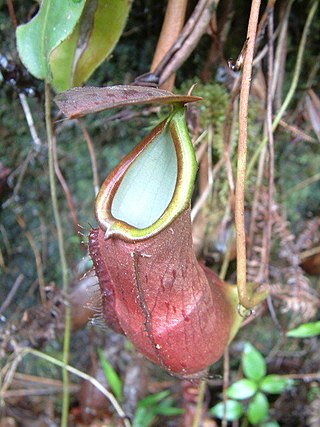
Nepenthes longifolia is a tropical pitcher plant endemic to Sumatra, where it grows at elevations of between 300 and 1100 m above sea level. The specific epithet longifolia, formed from the Latin words longus (long) and folius (leaf), refers to the exceptionally large leaves of this species.

Nepenthes jacquelineae is a tropical pitcher plant endemic to the Indonesian island of Sumatra. Due to its unique pitcher morphology, it is considered to be one of the most spectacular Nepenthes species native to the island.

Nepenthes dubia is a tropical pitcher plant endemic to the Indonesian island of Sumatra, where it grows at an altitude of 1600–2700 m above sea level. The specific epithet dubia is the Latin word for "doubtful".
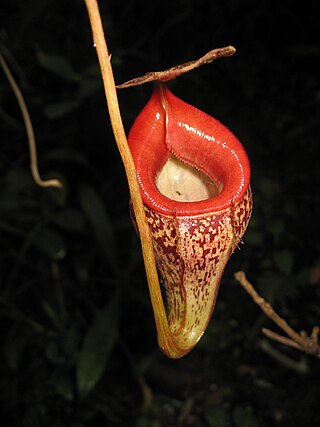
Nepenthes talangensis is a tropical pitcher plant endemic to Sumatra, where it grows in upper montane forest at elevations of 1800–2500 m above sea level.

Nepenthes tenuis is a tropical pitcher plant endemic to the Indonesian island of Sumatra. The species was first collected in 1957, from a remote mountain in the western part of the island. It remained undescribed until 1994, and was only rediscovered in the wild in 2002. Prior to this, N. tenuis was known solely from a single photograph and dried herbarium specimen.

Nepenthes rigidifolia is a critically endangered tropical pitcher plant endemic to Sumatra, where it grows at elevations of 1000–1600 m above sea level.
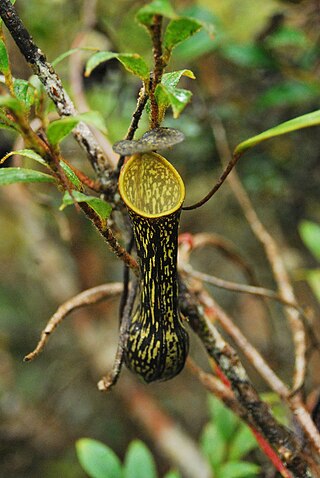
Nepenthes mikei is a tropical pitcher plant endemic to Sumatra. It is characterised by its black mottled lower and upper pitchers. The species is closely related to N. angasanensis and N. tobaica.
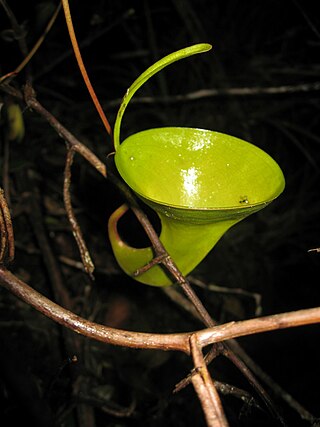
Nepenthes inermis is a tropical pitcher plant endemic to the Indonesian island of Sumatra. The specific epithet inermis is Latin for "unarmed" and refers to the upper pitchers of this species, which are unique in that they completely lack a peristome.

Nepenthes izumiae is a tropical pitcher plant endemic to Sumatra, where it grows in montane forest at 1700–1900 m above sea level. It appears to be most closely related to N. lingulata and N. singalana.

Nepenthes rhombicaulis is a tropical pitcher plant endemic to Sumatra. The specific epithet rhombicaulis is formed from the Latin words rhombicus, meaning "rhomboid", and caulis, "stem". It refers to the cross-sectional shape of the stem internodes.

Nepenthes ovata is a tropical pitcher plant endemic to Sumatra. The specific epithet ovata is Latin for "ovate" and refers to the shape of the lower pitchers.

Nepenthes jamban is a tropical pitcher plant endemic to northern Sumatra. The specific epithet jamban is the Indonesian word for "toilet" and refers to the shape of the pitchers.

Nepenthes lingulata is a tropical pitcher plant endemic to northern Sumatra. The species is characterised by the highly developed appendage present on the underside of the lid. The specific epithet lingulata is derived from the Latin word lingula, meaning "small tongue", and refers to this unique morphological feature.
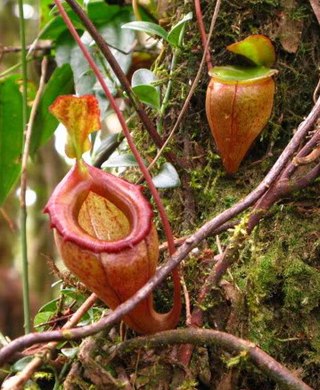
Nepenthes flava is a tropical pitcher plant endemic to northern Sumatra, where it grows in montane forest at 1800–2200 m above sea level.

Nepenthes micramphora is a tropical pitcher plant known only from Mount Hamiguitan on the island of Mindanao in the Philippines. It is a highland plant growing at elevations of 1100–1635 m.

Nepenthes andamana is a tropical pitcher plant endemic to Phang Nga Province, Thailand, where it grows near sea level in coastal savannah and grassland. It is thought to be most closely related to N. suratensis.
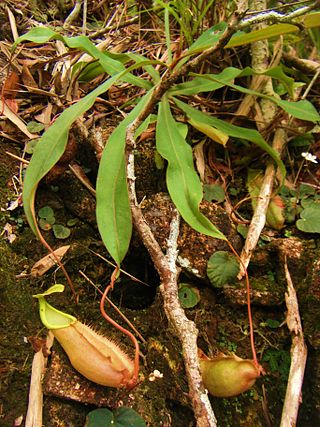
Nepenthes chang is a tropical pitcher plant endemic to the Banthad Mountains of central Thailand, where it grows at elevations of 300–600 m above sea level. It is thought to be most closely related to N. kampotiana.
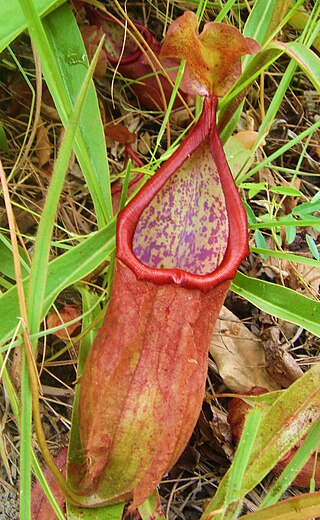
Nepenthes suratensis is a tropical pitcher plant endemic to Surat Thani Province, Thailand, where it grows near sea level in coastal savannah and grassland. It is thought to be most closely related to N. andamana.


























